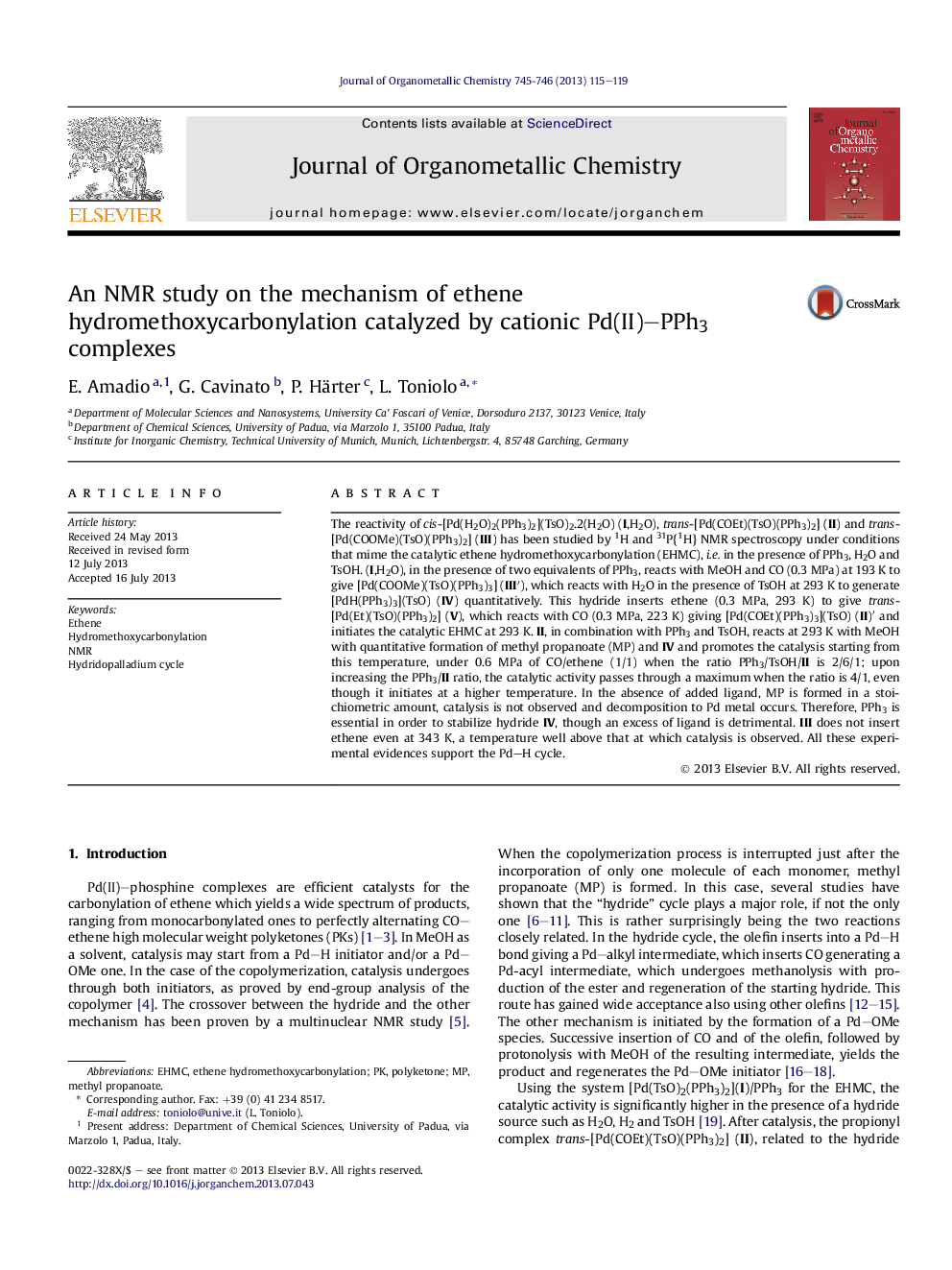| کد مقاله | کد نشریه | سال انتشار | مقاله انگلیسی | نسخه تمام متن |
|---|---|---|---|---|
| 1321522 | 1499894 | 2013 | 5 صفحه PDF | دانلود رایگان |

• Ethene hydromethoxycarbonylation catalyzed by cationic Pd(II)/PPh3/H2O/TsOH.
• All the key intermediates of a “Pd–H” cycle have been detected by VT NMR.
• The reactivity of Pd–H, Pd–Et and Pd–COEt intermediates supports the “Pd–H” cycle.
• H2O promotes catalysis and converts Pd–COOMe into an active Pd–H initiator.
• The “Pd–COOMe” cycle is unlikely also because ethene does not insert into Pd–COOMe.
The reactivity of cis-[Pd(H2O)2(PPh3)2](TsO)2.2(H2O) (I,H2O), trans-[Pd(COEt)(TsO)(PPh3)2] (II) and trans-[Pd(COOMe)(TsO)(PPh3)2] (III) has been studied by 1H and 31P{1H} NMR spectroscopy under conditions that mime the catalytic ethene hydromethoxycarbonylation (EHMC), i.e. in the presence of PPh3, H2O and TsOH. (I,H2O), in the presence of two equivalents of PPh3, reacts with MeOH and CO (0.3 MPa) at 193 K to give [Pd(COOMe)(TsO)(PPh3)3] (III′), which reacts with H2O in the presence of TsOH at 293 K to generate [PdH(PPh3)3](TsO) (IV) quantitatively. This hydride inserts ethene (0.3 MPa, 293 K) to give trans-[Pd(Et)(TsO)(PPh3)2] (V), which reacts with CO (0.3 MPa, 223 K) giving [Pd(COEt)(PPh3)3](TsO) (II)′ and initiates the catalytic EHMC at 293 K. II, in combination with PPh3 and TsOH, reacts at 293 K with MeOH with quantitative formation of methyl propanoate (MP) and IV and promotes the catalysis starting from this temperature, under 0.6 MPa of CO/ethene (1/1) when the ratio PPh3/TsOH/II is 2/6/1; upon increasing the PPh3/II ratio, the catalytic activity passes through a maximum when the ratio is 4/1, even though it initiates at a higher temperature. In the absence of added ligand, MP is formed in a stoichiometric amount, catalysis is not observed and decomposition to Pd metal occurs. Therefore, PPh3 is essential in order to stabilize hydride IV, though an excess of ligand is detrimental. III does not insert ethene even at 343 K, a temperature well above that at which catalysis is observed. All these experimental evidences support the Pd–H cycle.
The reactivity of cis-[Pd(H2O)2(PPh3)2](TsO)2, trans-[Pd(COEt)(TsO)(PPh3)2] and trans-[Pd(COOMe)(TsO)(PPh3)2] is studied by 1H and 31P{1H} NMR spectroscopy under conditions that mime the catalytic ethene hydromethoxycarbonylation. All the key intermediates of the Pd–H cycle are detected.Figure optionsDownload as PowerPoint slide
Journal: Journal of Organometallic Chemistry - Volumes 745–746, 15 November 2013, Pages 115–119